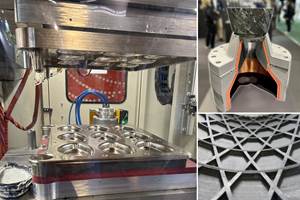Suppliers team to amp Viking 80C performance
Thanks to a coordinated effort with its fabric, core and panel suppliers, Viking Yachts was able to introduce carbon fiber cost-effectively, shaving weight and boosting speed in its new 24m-long 80C model.
A well-known builder of performance sportfishing and cruising vessels, Viking Yachts (New Gretna, NJ, US), partnered with key suppliers, 3A Composites (High Point, NC, US), Mahogany Co. (Mays Landing, NJ, US) and Vectorply (Phenix City, AL, US), to replace fiberglass mat and woven roving with noncrimp fabrics in the 1990s, and to introduce infusion in the 2000s.
“We’ve worked with Viking for decades,” recalls 3A Composites product development manager Russell Elkin, “but as a core supplier, you can’t just recommend core, but must consider all of the materials in the laminate, because they all work together.” Thus, when Viking began looking, again, to cut weight and boost performance across its models, it called on the same team to discuss options.
“The idea was to begin using carbon fiber,” says Elkin, “but because it’s more expensive, the question was where and how to employ it most efficiently.” Reinforcements supplier Vectorply compiled initial material studies, using its proprietary VectorLam Cirrus software and suggested replacing typical but bulky 48-oz/yd2 (1,628-g/m2) and 64-oz/yd2 (2,170-g/m2) E-glass quadraxial fabrics with lighter 35-oz/yd2 (1,187-g/m2) and 44-oz/yd2 (1,492-g/m2) hybrid carbon/E-glass quads in selected laminates.
According to Viking Yachts’ VP of design and engineering, Lonni Rutt, Viking’s 80C 80-ft/24m convertible (which offers an interior salon and more cabin space than Viking’s express style) was the perfect model to trial the hybrids. “We were looking to bring a new model between the 76-ft [23m] and 82-ft [25m] class that was more efficient with better performance and more room,” says Rutt. “Because we are limited in horsepower when you get to that size, performance is all about weight — a lighter boat is going to go faster.”
The suppliers worked together to complete several test matrices using the new materials, AME 6001 INF-35 vinyl ester infusion resin from Ashland Performance Materials (Columbus, OH, US) with Norox MCP-75 initiator from United Initiators (Elyria, OH, US). Testing was completed in November 2013, which included tensile, compressive, and flexural properties in the 0°, 90° and 45° (bias) orientations. Vectorply and 3A Composites then worked with Viking engineers to finalize 80C hull bottom and side laminates, using ABS High Speed Craft scantling rules as guidelines. Samples of Vectorply EC-QXM 3508 and 4408 hybrid quadraxial fabrics were sent to Mahogany for cutting and kitting, then forwarded to Viking for in-house process testing.
Mahogany pre-cuts and kits reinforcements and core materials for all Viking models. “We touch every composite part, from hulls and decks to stringers and bulkheads to floors and tanks,” says Mahogany’s VP of sales George P. Aaron. “Viking sends us the CAD files and we generate the kit patterns.” He notes that with the large size of Viking’s boats and backlog, the kitting provides needed production efficiency: “They receive a finished kit and can begin installation immediately.”
The team worked to further minimize weight, optimizing the sandwich laminates for core density and thickness, according to loads and location. 3A’s BALTEK SB.100 balsa is used in the hull bottom while lower density BALTEK SB.50 is used in the hull sides. The deck’s sandwich construction is cored with a combination of BALTEK balsa and AIREX polyvinyl chloride (PVC) foam core.
Viking also incorporates sandwich panels for bulkheads and soles, cut to net shape and kitted by Mahogany, using 3A’s AIREX C70.75 (75 kg/m3) PVC foam core and Vectorply E-LTM 1208 glass fabric skins. These composite panels also help to keep weight in check.
Production of the first 80C in early 2015 showed phenomenal results. Not only did it achieve a top speed of >41 knots — roughly 3.5 knots better than the 82-ft/25m boat — it also outpaced the smaller 76-ft/23m model. Rutt credits much of the success to team members. “A tremendous benefit for our company has been the specific knowledge everybody brings to the table,” he says. “You collaborate with people who have the opportunity to see other things and bring new, different ideas.” Elkin adds, “We were able to deliver a fully optimized composites package as a supplier team.”
Related Content
Plant tour: Teijin Carbon America Inc., Greenwood, S.C., U.S.
In 2018, Teijin broke ground on a facility that is reportedly the largest capacity carbon fiber line currently in existence. The line has been fully functional for nearly two years and has plenty of room for expansion.
Read MoreOtto Aviation launches Phantom 3500 business jet with all-composite airframe from Leonardo
Promising 60% less fuel burn and 90% less emissions using SAF, the super-laminar flow design with windowless fuselage will be built using RTM in Florida facility with certification slated for 2030.
Read MoreJEC World 2024 highlights: Thermoplastic composites, CMC and novel processes
CW senior technical editor Ginger Gardiner discusses some of the developments and demonstrators shown at the industry’s largest composites exhibition and conference.
Read MoreDevelopment of a composite liquid hydrogen tank for commercial aircraft
Netherlands consortium advances cryogenic composites testing, tank designs and manufacturing including AFP, hybrid winding, welding of tank components and integrated SHM and H2 sensors for demonstrators in 2025.
Read MoreRead Next
Next-gen fan blades: Hybrid twin RTM, printed sensors, laser shock disassembly
MORPHO project demonstrates blade with 20% faster RTM cure cycle, uses AI-based monitoring for improved maintenance/life cycle management and proves laser shock disassembly for recycling.
Read MoreCeramic matrix composites: Faster, cheaper, higher temperature
New players proliferate, increasing CMC materials and manufacturing capacity, novel processes and automation to meet demand for higher part volumes and performance.
Read MoreScaling up, optimizing the flax fiber composite camper
Greenlander’s Sherpa RV cab, which is largely constructed from flax fiber/bio-epoxy sandwich panels, nears commercial production readiness and next-generation scale-up.
Read More












